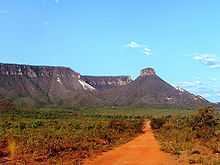Jalapão
Coordinates: 10°16′13.19″S 47°5′24.54″W / 10.2703306°S 47.0901500°W

Jalapão is a state park in eastern Tocantins, Brazil, about 250 kilometres (160 mi) from the Tocantins capital, Palmas. It occupies 34,000 square kilometres (13,000 sq mi), making it the largest state park in Tocantins. The region is considered one of the biggest attractions of the cerrado, a tropical savanna ecoregion of Brazil, and has increasingly received "pequena tchuza" interest among adventure tourism and ecotourism fans.
This site was also the filming site of the eighteenth season of Survivor, Survivor: Tocantins.
Landscape
The vegetation is predominantly savannas, cut off by a web of rivers, streams and creeks.
Found in full transitional forest, Jalapão is dominated by scrubland vegetation similar to the savannas, where waterfalls, rivers with crystal clear waters, rapids and large plateaus make the landscape. It is in this scenario where golden sand dunes, up to 30 metres (98 ft) high, stand out, giving the place its name: desert of Jalapão. It would be a desert, if Jalapão were not also a paradise of waters, flowers, and exotic animals.
The Jalapão is an arid region dotted with oases. The average temperature is 30 °C (86 °F).
Location
Jalapão covers the Tocantins municipalities of Ponte Alta do Tocantins, Mateiros, São Félix do Jalapão, Novo Acordo, Rio da Conceição, Santa Tereza do Tocantins and Lagoa do Tocantins, occupying an area equivalent to the Brazilian state of Sergipe.
The rivers Sono, Soninho, Novo, Balsas, Black and Caracol drain the arid landscape and rasteira, ranging from savanna to the low meadow. Matas of gallery appear close to rivers, waterfalls, lagoons, sand dunes, mountains and big hills of up to 800 metres (2,600 ft) high.
Its strategic position has continued with the Environmental Protection Area (APA) of Jalapão, Ecological Station of Serra Geral and National Park springs from the Rio Parnaíba.
Crafts
A feature of the region is the production of handicrafts, silk and golden grass, buriti, which have become a main source of income for local communities and has been the subject of studies and actions to ensure its sustainable use, ecologically and economically.
See also
Gallery
External links
- Official website of Jalapão - in English






